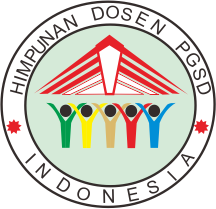ASSESMEN DIAGNOSTIK KEMAMPUAN LITERASI BACA TULIS SISWA FASE A: IMPLEMENTASI PROGRAM KDS 2023 DI SD NEGERI SOBO
DOI:
https://doi.org/10.23969/jp.v9i3.18531Keywords:
Assessment, Diagnostic, Early, Reading And Writing, LiteracyAbstract
This study aims to conduct a diagnostic assessment of the literacy skills of phase A UPTD SDN Sobo students with aspects of recognizing letters, aspects of reading syllables, aspects of reading words, and aspects of reading comprehension. This research uses descriptive qualitative and the research subjects are class 1 and class 2 with each number of students: class 1 has 13 students present while class 2 has 22 students, with the diagnostic assessment instrument of phase A literacy skills used in the form of observation, interviews, and documentation. The results of the research on the diagnostic assessment of students' literacy skills in phase A of UPTD SDN Sobo can be obtained data: class 1 in the aspect of recognizing letters with the category less because students are only able to mention letters that are rarely used, namely X and Y with a percentage of 61.5%, the aspect of writing letters with the category less percentage 41.6%, the aspect of reading syllables with the category less percentage 96.2%, the aspect of reading words with the category less percentage 92.3%, the aspect of reading comprehension with the category less percentage 92.3%. While class 2 in the aspect of recognizing letters in the category of less percentage 0%, the aspect of writing letters in the category of less percentage 0%, the aspect of reading syllables in the category of less with a percentage of 0%, the aspect of reading words in the category of less with a percentage of 0%. The aspect of reading comprehension with the category lacking a percentage of 78.9%, the aspect of writing sentences with the category lacking a percentage of 68.4%. Based on the diagnostic assessment data, it can be concluded that the literacy skills of phase A UPTD SDN Sobo students are still low. The involvement of researchers in this activity has a good impact on students at UPTD SDN Sobo because students who have not been able to read and write little by little and with reading and writing guidance students are able to read and write even though they are not perfect as desired.Downloads
References
Aan Komariah, Djam’an Satori (2011). Metode Penelitian Kualitatif. Bandung, Alfabeta
Ambarita, R. S., Wulan, N. S., & Wahyudin, D. (2021). EDUKATIF: JURNAL ILMU PENDIDIKAN.
Cahya, A. D., Rahmadani, D. A., Wijiningrum, A., & Swasti, F. F. (2021). Analisis pelatihan dan pengembangan sumber daya manusia. YUME: Journal of Management, 4(2).
Desfitri, E., & Yulisna, R. (2023). Sosialisasi Pentingnya Literasi Membaca Bagi Siswa SD di Kampung Sungai Salak Pesisir Selatan. INTEGRATIF: Jurnal Pengabdian Kepada Masyarakat, 1(1), 34-38.
Dewi, S. U. S. (2015). Pengaruh metode multisensori dalam meningkatkan kemampuan membaca permulaan pada anak kelas awal sekolah dasar. Modeling: jurnal program studi PGMI, 2(1), 1-13.
Ginting, E. S. (2021). Penguatan literasi di era digital. In Prosiding Seminar Nasional Pembelajaran Bahasa dan Sastra Indonesia (SemNas PBSI)-3 (pp. 35-38). FBS Unimed Press.
Hanifa, U. (2023). Pengaruh Media Pembelajaran Pasir Kinetik Terhadap Kemampuan Menulis Pada Pembelajaran Tematik Siswa Kelas 1 SD N 1 Tulus Ayu (Doctoral dissertation, Universitas Nurul Huda).
Hijjayati, Z., Makki, M., & Oktaviyanti, I. (2022). Analisis Faktor Penyebab Rendahnya Kemampuan Literasi Baca-Tulis Siswa Kelas 3 di SDN Sapit. Jurnal Ilmiah Profesi Pendidikan, 7(3b), 1435- 1443.
Ismi Arum Mawarensa (2022) file:///C:/Users/Acer%20E1-471/Downloads/112- Article%20Text-288-1-10-20220904%20(1).pdf
Komalawati, R. (2020). Manajemen Pelaksanaan Tes Diagnostik Awal Di Sekolah Dasar Pasca Belajar Dari Rumah Untuk Mengidentifikasi Learning Loss. Jurnal Edupena, 1(2), 135-148
Laily, I. F. (2014). Hubungan kemampuan membaca pemahaman dengan kemampuan memahami soal cerita matematika sekolah dasar. Eduma: Mathematics Education Learning and Teaching, 3(1).
Manizar, E. (2015). Peran guru sebagai motivator dalam belajar. Tadrib, 1(2), 204-222.
Menteri Pendidikan Nasional Republik Indonesia. (2014). Peraturan Menteri Pendidikan Nasional No 137 Tahun 2014 tentang Standar Nasional Pendidikan Anak Usia Dini. In Menteri Pendidikan Dan Kebudayaan Republik Indonesia (pp. 1–76).
Muslih, M. A., & Hasan, N. (2022). Analisis Kemampuan Membaca Permulaan pada Siswa Kelas 2 di SD Negeri Pekojan 02 Petang Kota Jakarta Barat. PANDAWA, 4(1), 66-83.
Muliawanti, S. F., Amalian, A. R., Nurasiah, I., Hayati, E., & Taslim, T. (2022). Analisis Kemampuan Membaca Pemahaman Siswa Kelas Iii Sekolah Dasar. Jurnal Cakrawala Pendas, 8(3), 860-869.
Nasution, S. W. (2022). Asesment kurikulum merdeka belajar di sekolah dasar. Prosiding Pendidikan Dasar, 1(1), 135-142.
Nurani, R. Z., Nugraha, F., & Mahendra, H. H. (2021). Analisis kesulitan membaca permulaan pada anak usia sekolah dasar. Jurnal Basicedu, 5(3), 1462-1470.
Sari, N. R., Hayati, F., & Harfiandi, H. (2021). Analisis Kemampuan Mengenal Huruf Abjad Pada Anak Kelompok A Di Tk Bungong Seleupok Banda Aceh. Jurnal Ilmiah Mahasiswa Pendidikan, 2(1).
Priyono, P., Muslim, I. F., & Widiyarto, S. (2022). Pemahaman Bacaan Siswa SMP Alikhlas Melalui Literasi Baca dan Tulis. Jurnal Ilmiah Wahana Pendidikan, 8(13), 494-498.
Rachmawati, A., & Lestariningrum, A. (2022, August). Penerapan Model Pembelajaran Inovatif Melalui Asesmen Diagnostik Dalam Menguatkan Literasi Anak Kelas 1 di SDN Banjaran 5. In Prosiding SEMDIKJAR (Seminar Nasional Pendidikan Dan Pembelajaran) (Vol. 5, pp. 891-898).
Relita, D. T., & Yosada, K. R. (2021). PENDAMPINGAN GURU DALAM MEMANFAATKAN LITERASI DIGITAL PADA PEMBELAJARAN DARING DI MASA COVID 19. Jurnal Pengabdian Masyarakat Khatulistiwa, 4(2), 58-66.
Satori. Djam‟an. 2011. Metode Penelitian Kualitatif. Bandung: Alfabeta Remaja Rosdakarya
Sari, N. R., Hayati, F., & Harfiandi, H. (2021). Analisis Kemampuan Mengenal Huruf Abjad Pada Anak Kelompok A Di Tk Bungong Seleupok Banda Aceh. Jurnal Ilmiah Mahasiswa Pendidikan, 2(1)
Simamora, K. F. (2022). Kemampuan HOTS Siswa Melalui Model PjBL Ditinjau dari Kemampuan Literasi Kimia Siswa. Jurnal Inovasi Pembelajaran Kimia (Journal Of Innovation in Chemistry Education), 4(1), 55-65.
Siregar, R. A. (2019). Upaya Meningkatkan Kemampuan Mengenal Huruf Menggunakan Media Kartu Kata Di Tk Negeri Pembina I Kota Jambi Tahun Pelajaran 2016/2017. Jurnal Literasiologi, 2(1), 16-16.
Ujione. https://ujione.id/asemen-diagnostik/.
Watu, A. Y., Sae, F. N., Wae, E., Wea, H. A., & Lawe, Y. U. (2024). PENGUATAN LITERASI BACA-TULIS SISWA FASE A MELALUI KEGIATAN LESSON STUDY DALAM IMPLEMENTASI PROGRAM KDS DI UPTD SDN SOBO. Jurnal Citra Magang dan Persekolahan, 2(1), 232-245.
Zhein, A. K. (2018). Pelaksanaan Gerakan Literasi Baca Tulis di SDN Madyopuro 2 Kecamatan Kedungkandang Kota Malang (Doctoral dissertation, Universitas Negeri Malang).
ZUL, H. (2022). ANALISIS FAKTOR PENYEBAB RENDAHNYA KEMAMPUAN LITERASI BACA-TULIS SISWA KELAS 3 DI SDN SAPIT (Doctoral dissertation, Universitas Mataram).
Downloads
Published
Issue
Section
License
Copyright (c) 2024 Pendas : Jurnal Ilmiah Pendidikan Dasar

This work is licensed under a Creative Commons Attribution 4.0 International License.



















